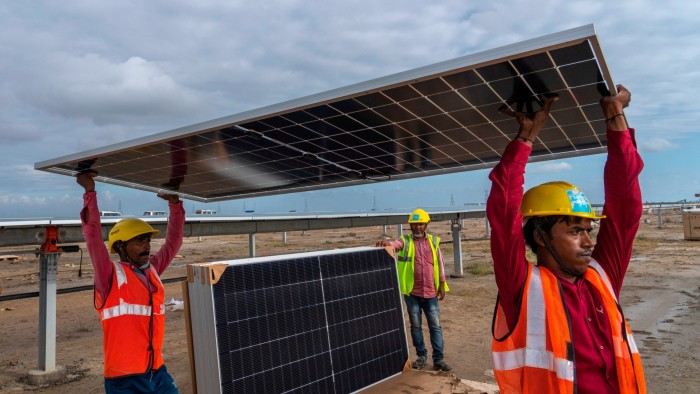This article is an on-site version of our Energy Source newsletter. Premium subscribers can sign up here to get the newsletter delivered every Tuesday and Thursday. Standard subscribers can upgrade to Premium here, or explore all FT newsletters
Welcome back to Energy Source, coming to you from London.
US President Donald Trump has delayed his tariffs on Mexico and Canada for 30 days after the countries announced moves to bolster security at their borders.
But in the meantime, China has changed the calculus for the coal, gas and oil markets, slapping its own tariffs on the resources.
What does it all mean? A headache for US refineries over the next month, as they navigate an uncertain supply chain. A potential boost for traders, who should profit from the uncertainty.
And an interesting new confidence from China, which is heavily reliant on imported oil and gas, but which has a couple of new cards to play.
Although it does not buy much US crude, China has a decreasing need for gasoline and diesel, as it boosts its electric car fleet.
The second is its closeness to Russia in the wake of the Ukraine war. It can now rely on its neighbour for large quantities of well-priced gas (and indeed oil).
China is a big buyer of US coal but has plenty of other options, including Australia, Indonesia and its own domestic production.
If the US does eventually impose tariffs on Canadian oil, China and the rest of Asia are expected to be major buyers.
On the gas front, the Chinese tariffs on US LNG are likely to drive more US shipments to Europe.
Which are the companies to keep an eye on? Aside from the obvious Canadian and US producers, pipeline and refinery operators, BP has some exposure to higher prices, since 40 per cent of its refinery capacity is in the US. The tariff threats are another concern for the UK oil major, which is already having a tough time with its investors.
In today’s Energy Source, we parse through a study on the investment trends shaping the energy transition in 2025. Thanks for reading — Malcolm
The latest trends in energy transition investment
Each year BloombergNEF, the renewable energy research arm of Mike Bloomberg’s empire, puts out a report looking at the money flowing into the energy transition.
This year’s report came out last week and the top line number was unsurprising. About $2.1tn was invested globally in the energy transition in 2024, an 11 per cent rise from the year prior (which is a slower pace of growth than in previous years). Most of the money was spent in China. The rate of investment needs to triple to keep the world on track to avoid a rise in temperature of more than 1.5C.

But there were some very interesting underlying details this year:
-
According to the report, solar, battery, battery metals and electrolyser manufacturing are all in a state of overcapacity. That suggests prices are likely to stay low this year, which is one reason why Gulf countries, for example, are moving heavily into solar farms backed up with huge amounts of storage batteries.
But the report’s authors said they had scaled back their estimates of future investment into these areas, since it expects many manufacturers will scale back their expansion plans, or drop them altogether.
-
Everything is still being made in China. The report found 81 per cent of supply chain investment was made in China in 2024, and the authors expect that to continue long into the future. While the US, Europe and India would like to manufacture their own solar panels and batteries, they don’t have the knowhow or the ability to be competitive on cost.
-
There is a growing split between sectors that are proven, with business models that are not dependent on cheap money or political support, and those that are not. Last year, 90 per cent of all investment went into electric vehicles, renewable energy generation and power grids.
One standout area was energy storage, which grew 36 per cent to $54bn of investment, more than the nuclear sector ($34bn), which was flat year on year.
Meanwhile, money moved away from areas that are higher risk, or that have yet to scale. Carbon capture and storage, heavily backed by the oil and gas industry, saw investment halve to just $6.1bn. Hydrogen investment dropped 42 per cent to $8.4bn.
“Emerging” technologies, such as electrified heat and carbon capture and storage, as well as clean industries (ie, for steel, cement or shipping) “face more fundamental challenges”. These technologies, which tend to be solutions for hard-to-abate sectors, only got 7 per cent of the total investment, or $154bn, a 23 per cent fall from the year before.
For many investors, these emerging technologies need more government support, including mandates to force their use, or subsidies. But the political climate appears to be shifting rapidly in the other direction, at least in the US and Europe. (Malcolm Moore)
Power Points
Energy Source is written and edited by Jamie Smyth, Myles McCormick, Amanda Chu, Tom Wilson and Malcolm Moore, with support from the FT’s global team of reporters. Reach us at energy.source@ft.com and follow us on X at @FTEnergy. Catch up on past editions of the newsletter here.
Recommended newsletters for you
Moral Money — Our unmissable newsletter on socially responsible business, sustainable finance and more. Sign up here
The Climate Graphic: Explained — Understanding the most important climate data of the week. Sign up here
https://www.ft.com/content/f83a0b51-c08e-42ef-b74c-668ac228b6c9


